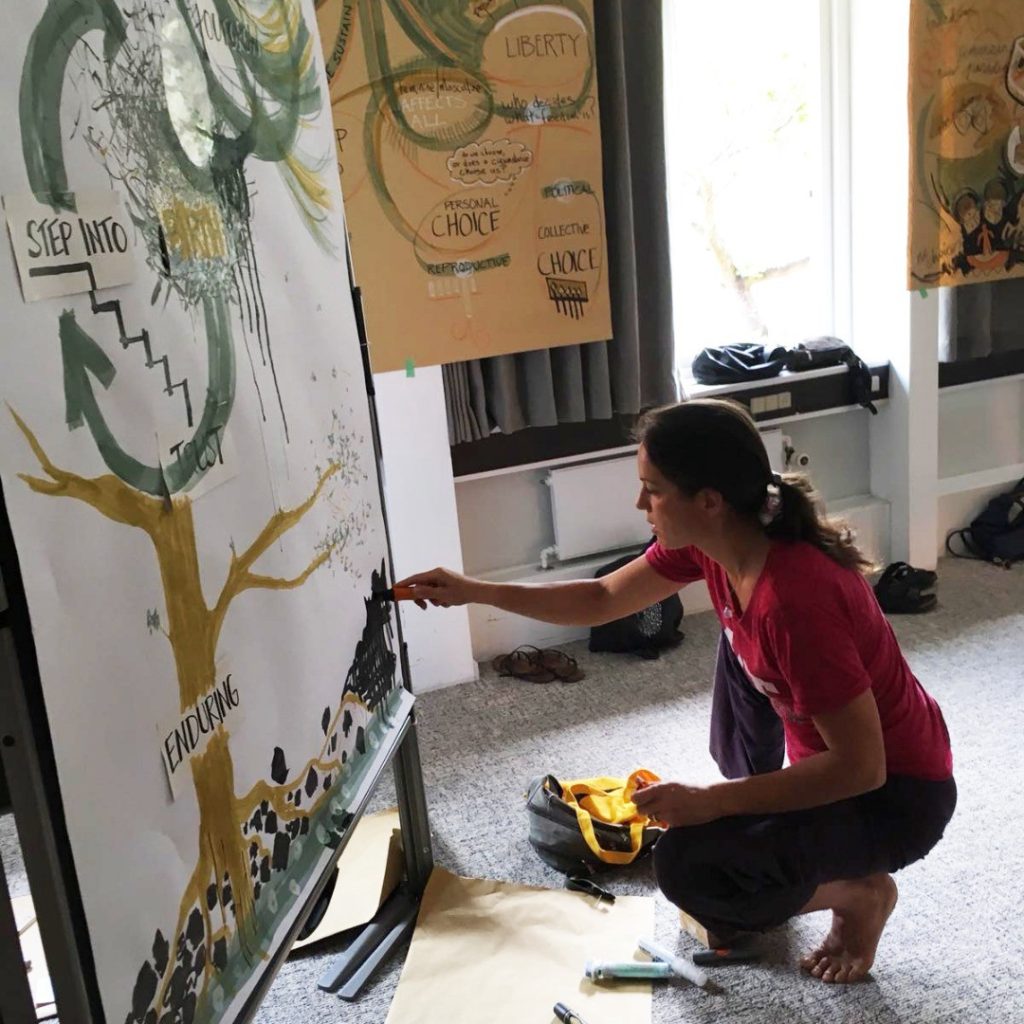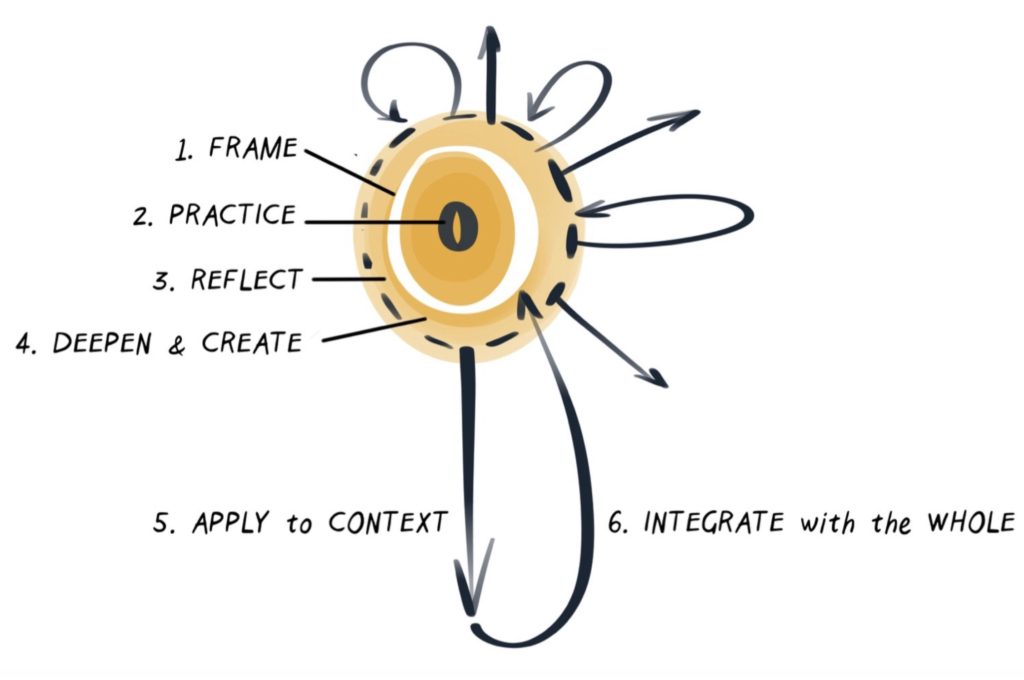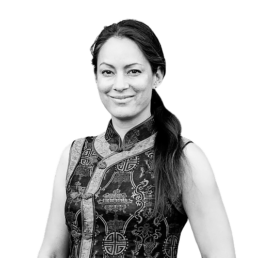
My journey as an online learner in the MITx Entrepreneurship 101 course on edX marked for me the beginning of a progressive discovery of the power and importance of community. There is a deep joy that can be experienced through building inspired and respectful collaborations, based on reciprocity and the feeling of something being moved forward together. Although working with one another is sometimes terribly challenging and certainly always complex, it might ultimately be the only effective way to create tangible and truly meaningful impact in the world. Adam Kahane’s “Collaborating with the Enemy: How to Work with People You Don’t Agree with or Like or Trust” has been key in helping me to formulate my more recent framing of community building: it is an exercise in stretch collaboration.
Something about controlling outcomes has to be let go of, and something about surrendering to not-knowing needs to be embraced, as a pathway towards unprecedented and pregnant possibility.
During a Visual Practice Workshop that I joined in July 2018, I tried to dig deeper into the feelings that were at the roots of my motivation and energy around staying involved with the Alumni community. After some solo time in Nature, and a journaling exercise that were part of the workshop programme, some keywords that emerged for me — in no particular order — were: birth, enduring, step into, trust, outgrow.

An emerging picture then began to form before me, through me, almost in spite of me — before I could even yet make sense of it. It gave me some clues regarding my inquiry into the essence and elements of leadership. There was:
- the quality of endurance (of being able to grow roots even in dry rocky terrain, pushing down deep enough to get to the rich underlying soil);
- the capacity to trust (oneself and others, sometimes despite an overall feeling of “not knowing” exactly);
- the courage to step into (that is, the capacity to show up and do whatever needs to be done, even if the space ahead looks like a void),
- in order to birth what it is that is wanting to be born (through my work, my energy and my capacities);
- and, finally, the culminating moment of outgrowing (in other words, the awareness of perhaps no longer being essential, or even needed, at all, and the grace and acceptance of being able to let go, with love.)
Here are some journaling notes pulled straight from my Ecosystem Leadership Program workbook:
WEEK 4 — Holding space
Deep listening is exhausting! How can I make it nurturing also for me, and not just others? Where is the boundary? And when is letting go even more impactful or useful than doing? Is excessive watchfulness and stewarding stifling the true manifestation that is wanting to emerge from the ecosystem? (15th May, 2019)
WEEK 5 — Accessing the open mind/heart/will.
As I lean into my crazy prototyping project with the community (a 24-hour online chat space dedicated to the 24 steps of Disciplined Entrepreneurship to take place on the 24th of May), I get stuck for a moment by one negative voice (or maybe it was just a questioning voice) that asked me “what is the intention behind this”? I suppose it just surfaces a question I carry within me, that does not have an articulated answer, except for the feeling that it is something that “wants to happen”. (22nd May, 2019)
The me/we — us/them tension is such a mystery. I have difficulty sometimes understanding the signals. What is the bigger ecosystem trying to manifest, and am I creating space for that to happen? For example, the 24-hour Zoom room idea came from Phil [edited name]. Everyone (including me) loved it, and I began to take action to make it happen, because I have the tools (and energy) for it (our networking platform, the connections with people, the community holding capacity, etc.) Then I started to feel too much load, so I asked Phil if he was still behind this initiative, how much he could put into it, and he replied “don’t worry, I am here to help and support you.” I thought to myself: “What? I am the one helping YOU!” I was very annoyed but I sat with the discomfort for a whole day. Then I began to understand that the “ownership” issue was a trap. What I needed to understand was something else: the real question here was, is this wanting to happen, and is there the energy for it? So it really does not matter, in the bigger picture, whether it’s “Phil helping Rachel” or “Rachel helping Phil” because that is beside the point. (22nd May, 2019)
The point of doubt is an interesting place to dwell. One cannot hurry through it, and trying to bypass it is a big mistake: it is the richest place of learning and insight — but it is also very lonely, and very uncomfortable. This is where the processes and community of practitioners from the ELP (Ecosystem Leaderhip Programme) fueled me with an incredible capacity to sit with — and through — the unease.
“And then, the surprising twist. That single, insinuating voice of doubt is overcome by the collective will that I feel emerging from beneath, even against my own spontaneous instinct of self-protection. In the very moment that my ego could let go completely of the performance angst connected to the prototype execution and its outcomes, something had already, in itself, been achieved, in the here and the now. And something was set in motion. There is community coalescing around just the trust, the courage, and the vunerability of not knowing exactly.” (ELP workbook journaling notes— 22nd May, 2019)
Ecosystem Leadership (ELP) Methods Applied
I wish to share the six steps of the Practice Research framework developed by the Presencing Institute team (and beautifully illustrated by my colleague, artist and generative scribe Kelvy Bird), that I was able to apply to our prototyping situation:

- Framing: defining the intention — our objective was to experiment what sort of initiative might serve to engage and nurture the community, creating value and meaning for everyone while remaining flexible and low-effort enough that people would readily make the time to engage.
- Practicing: experimenting our way forward through prototyping — we kept the action rolling quickly, without getting too attached to specific ideas or outcomes, to learn by doing.
- Reflecting: processing insights gained and noticing from things tried — it was very informative to see some parts fall through, and others gain momentum, beyond the desire to predict and control.
- Deepening & Creating: using social arts (generative scribing — as described earlier, embodiment — through Social Presencing Theater) and creative journaling , to deepen inquiry and insights.
Surrendering to the dialogue is difficult, and when it happens, there is a palpable shift. And that shift really sits physically in the body I feel, there is something that happens in the chest and in the heart, and in the in-between space that connects us to the other person (or the group/community).
(ELP workbook journaling notes — 22nd May, 2019)
- Applying to Context: implementing and applying new learnings in context — it was necessary to keep feedback loops swift and open and be ready to rethink assumptions, based on how each action was (or wasn’t) generating results.
- Integrating with the Whole: sharing with others in the ecosystem and beyond — we were very aware that anything we were able to create and harvest during the 24-hour event needed to make sense in a larger community context, to include also those who were not able to take part directly in the initiative. Taking this one step further, another question might be “how do we bring this body of work into the world, beyond the boundaries of this community, and what could that look like?”
Epilogue—Some Closing Thoughts
Wrestling with the notion of leadership, community and prototyping through the process of linking research, action and integration over the past four years has brought me some of the following learnings.
On leadership and vulnerability: trying to hold together in a predetermined framework a very diverse community of brilliant, entrepreneurial individuals is like trying to herd cats – theoretically and practically impossible. Holding space for that community, on the other hand, is a different way to approach and frame the question, and perhaps the only possible way to move forward: through flexibility and a genuinely co-creative stance.
On tenacity and patience: community fabric is woven slowly, painstakingly over time, and not an overnight phenomenon. Much of the time needs to be spent waiting, because patience and coherence are the only factors that can truly generate trust.
On overcoming the “empty room” syndrome: being “in service of” entails a great amount of invisible work, as well as risk-taking. It may well be that nobody turns up. You need to be make peace with your own worse case scenario, as a way to free up possibility, which is what — ultimately — will likely end up drawing people into the space. The voices of cynicism, doubt and fear need to be put to rest by recognising and acknowledging them in order to push past.
On self-awareness and mindfulness: making sure to factor in time and space for oneself is critical and too often overlooked, and a difficult trap to avoid. One of the breakthrough achievements for me during the 24-hour project was to keep space for myself, thereby leaving space for others to step up their game and take the helm.
On surrendering to the unknown:
letting go (of control, of predictions, of wishful thinking and of outcomes) is — I believe — the most powerful way to unlock infinite possibility. Surprise and gratitude are the reward.
I have had to let go of a desire to have a go-to, all-encompassing Alumni channel. I have “surrendered” to the fact the community wants use a combination of channels: Whatsapp, a variety of Facebook groups, Facebook Messenger, the Google suite of online collaboration tools, Zoom and Skype for video connection. People need to be met at the point where they are: while some behaviours can be shaped over time through modeling desired outcomes, it’s impossible to force people into new habits.
What, you may perhaps ask, is all of this ultimately worth? My personal answer to this question is: it’s priceless. It’s the grand prize of daring greatly, to partake of an unprecedented, emerging future. In final closing, here are some thoughts I had the privilege to share in a recent interview hosted by Mighty Networks: https://youtu.be/bUhfvPl5L0s
Footnote: this is the 5th of 5 articles adapted for the Disciplined Entrepreneurship website, from an original article by Rachel Hentsch, published on Medium.
The author
Rachel Hentsch
Rachel Hentsch is an MIT-Certified Teacher in New Ventures Leadership. She is passionate about strengthening global communities, using tech tools to connect dots. She heads communications at the Presencing Institute and has been researching and prototyping ways to keep global community members connected meaningfully.

The Disciplined Entrepreneurship Toolbox
Stay ahead by using the 24 steps together with your team, mentors, and investors.
The books
This methodology with 24 steps and 15 tactics was created at MIT to help you translate your technology or idea into innovative new products. The books were designed for first-time and repeat entrepreneurs so that they can build great ventures.

How relevant was this article to you?
Click on a star to rate it!
Average rating 4.8 / 5. Vote count: 4
No votes so far! Be the first to rate this post.
We are sorry that this article was not useful for you!
Let us improve this post!
Tell us how we can improve this post?

Rachel, I am so grateful for your honesty in writing this post. The idea that we work with people to ‘birth’ something new even when we don’t know that we like (or even trust) them is salient. I am in the early stages of this process in my local community, and so your reminder to hold space for others, to be patient, and to act with coherence is truly encouraging.